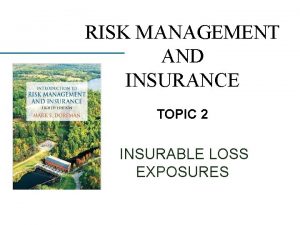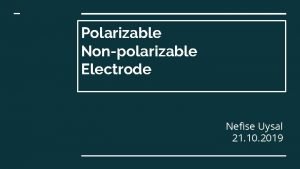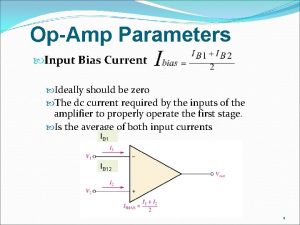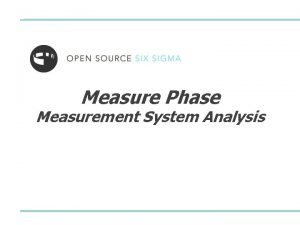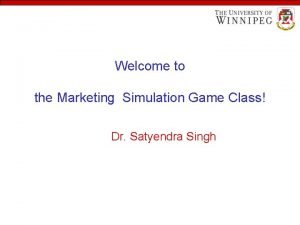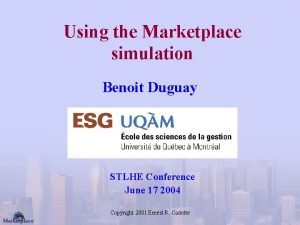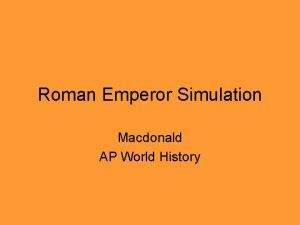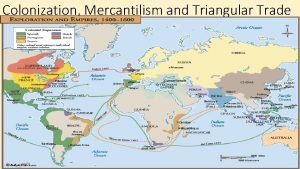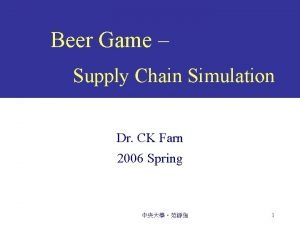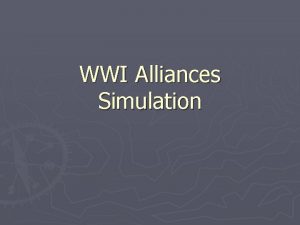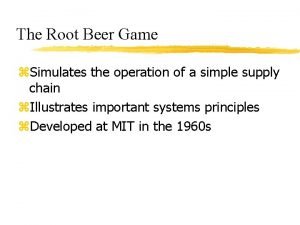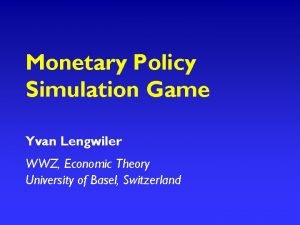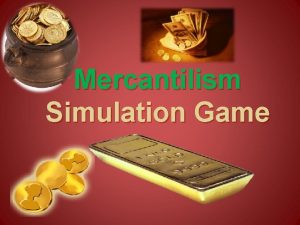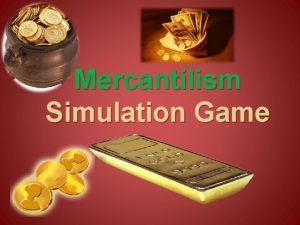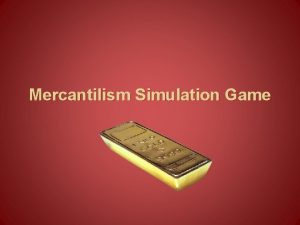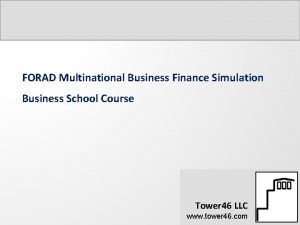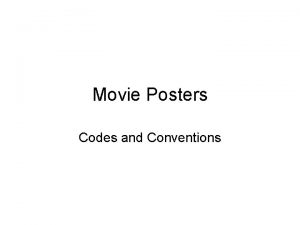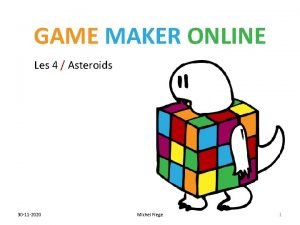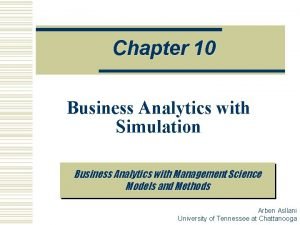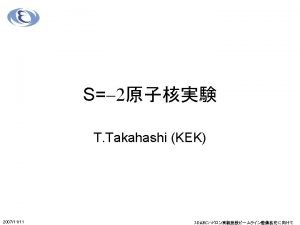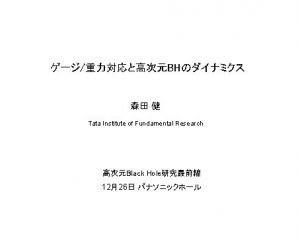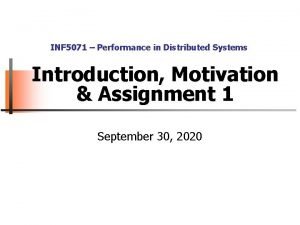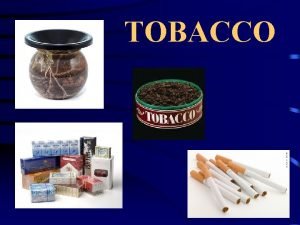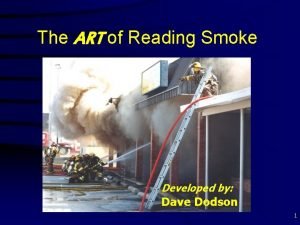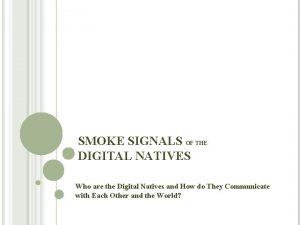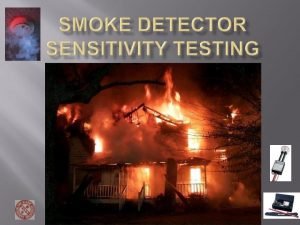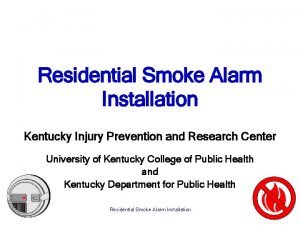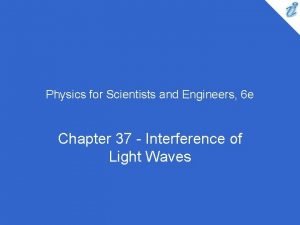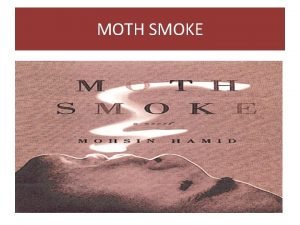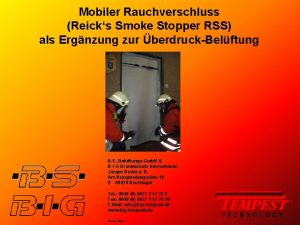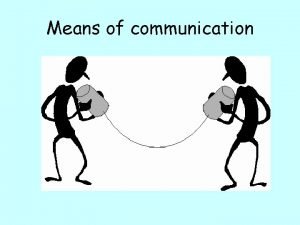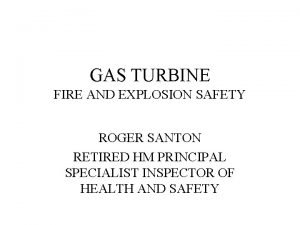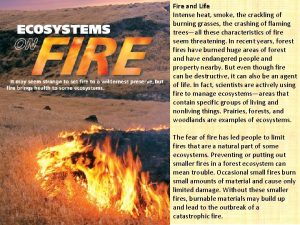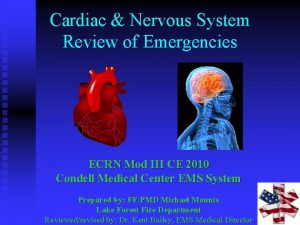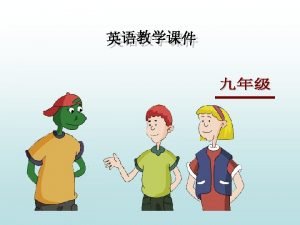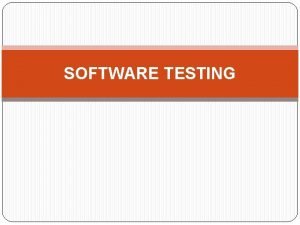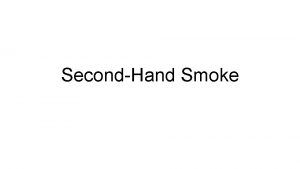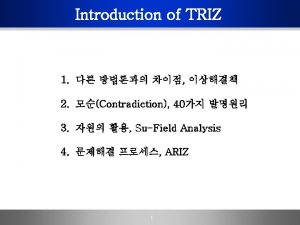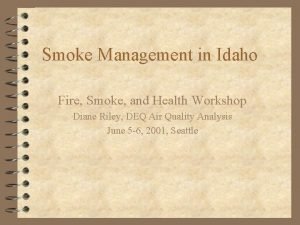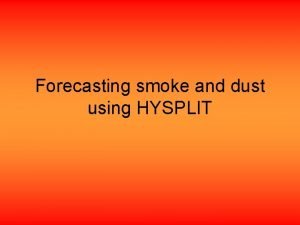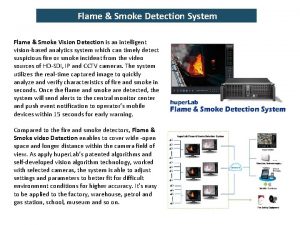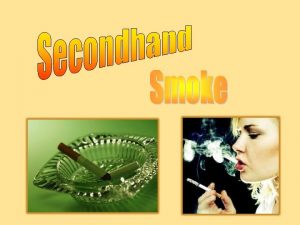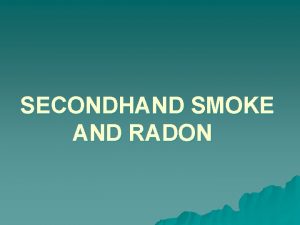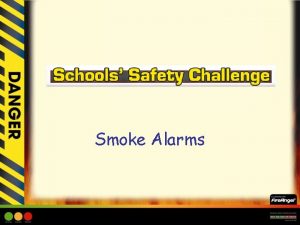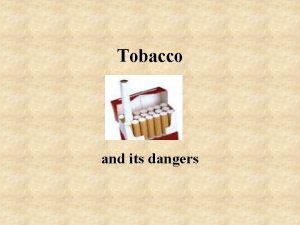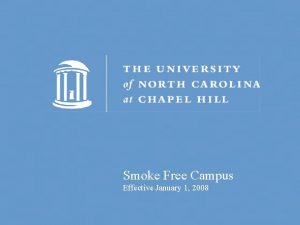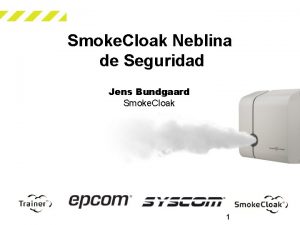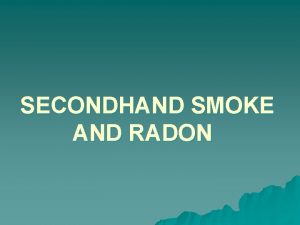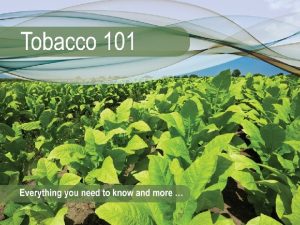SMOKE SIMULATION Motivation Movie Game Engineering Introduction Ideally












































![Smoke Rendering Thick smoke: plain particles Thin smoke: adaptive particles [AN 05] accumulate stretching Smoke Rendering Thick smoke: plain particles Thin smoke: adaptive particles [AN 05] accumulate stretching](https://slidetodoc.com/presentation_image/4bcef4fb715802c02416fc8e8d39cb2a/image-45.jpg)



- Slides: 48

SMOKE SIMULATION

Motivation Movie Game Engineering

Introduction Ideally Looks good Fast simulation Looks good? Look plausible Doesn’t need to be exactly correct doesn’t suffer from excessive numerical dissipation

Overview Simulation Compressible/Imcompressible Equation Vortex particle method Using octree data structure Rendering Thick smoke: plain particles Thin smoke: adaptive particles Using Compensated Ray Marching

Compressible Fluids Yngve, G. D. , O'Brien, J. F. , Hodgins, J. K. , 2000, Animating Explosions. The proceedings of ACM SIGGRAPH 2000, New Orleans, July 23 -28, pp. 29 -36.

Operator Splitting Stam used the technique in his Stable Fluids paper, 1999. Allows us to solve the Navier-Stokes equation in Parts. As long as each part is stable the technique will be stable.

Semi-Lagrangian Convection Trace each point p in the field backwards in time. The new velocity at x is therefore the velocity that the particle had a time step ago at the old location.

Smoke Viscous Diffusion In the simulation of smoke, it is reasonable to consider the fluid inviscid. Therefore this term is zero and need not be solved for. In fact, the implicit solver that is used will take energy away from the system anyway, so there is a numerical dampening that can look like a non-zero viscosity.

Body Forces Gravity, user forces, and object interaction. The visible smoke is from a density field. Areas of high density fall in the direction of gravity. Heat moves against gravity (hot air rises).

Incompressibility At each time step we start with a velocity field that is divergence free. We need this to be true at the end of the time step because the fluid is incompressible. After solving for convection, and body forces the velocity field is not divergence free.

Incompressibility Fedkiw, R. , Stam, J. and Jensen, H. W. , "Visual Simulation of Smoke", SIGGRAPH 2001, 23 -30 (2001).

Incompressible Euler Equations self-advection Forces incompressible (Navier-Stokes without viscosity)

Additional Equations We now know all the finite differences we need to add the forces for heat and density… smoke’s density temperature

Vorticity Confinement The numerical dissipation, and the coarse grid size, cause the fine scale detail of turbulent swirling smoke to vanish. Identify where the curl is highest, and add back in a rotational force there. “Vorticity Confinement” force preserves swirling nature of fluids.

What is vorticity? A measure of the local rotation in a fluid flow.

Pressure Boundary Conditions A Neumann boundary condition is a restriction on the derivative of a function.

Velocity Boundary Condition A Dirichlet boundary condition is a restriction on the value of a function.

Vorticity Confinement

Vorticity Confinement

Vorticity Confinement

Solving the System Need to calculate: Start with initial state Calculate new velocity fields New state:

Smoke Simulation While (simulating) Get external forces (if any) from UI Get density/heat sources (from UI or init grid cells) Update velocity Update density Update temperature Display density

Smoke Simulation While (simulating) Get external forces (if any) from UI Get density/heat sources (from UI or init grid cells) Update velocity Update density Update temperature Display density

Update Velocity Equation: First term: Advection Move the fluid through its velocity field (Du/Dt=0) Second term: external forces Final term: pressure update

Update Velocity Add external forces (fbuoy + forces from UI + fconf) Advection (semi-lagrangian step – trace particles back) Pressure update (solve linear system)

Smoke Simulation While (simulating) Get external forces (if any) from UI Get density/heat sources (from UI or init grid cells) Update velocity Update density Update temperature Display density

Update density Equation First term: Advection Move the temperature through velocity field Second term: Diffusion Can skip this term Second term: external sources

Update density Add Sources (pick grid cells or from UI) Advection (semi-lagrangian step – trace particles back) Diffusion (solve linear system – can skip this step)

Smoke Simulation While (simulating) Get external forces (if any) from UI Get density/heat sources (from UI or init grid cells) Update velocity Update density Update temperature Display density

Update temperature Equation First term: Advection Move the temperature through velocity field Second term: Diffusion Can skip this term

Update Temperature Add Sources (grid cells or objects or UI) Advection (semi-lagrangian step – trace particles back) Diffusion (solve linear system – can skip this step)

Smoke Simulation While (simulating) Get external forces (if any) from UI Get density/heat sources (from UI or init grid cells) Update velocity Update density Update temperature Display density

Display density Use any approach you want Visualize the density field: just opengl render a bunch of cubes (corresponding to grid cells) that have alpha values based on how dense the smoke is.

Numerical Dissipation ‘Stable Fluids’ method dampens the flow Typical with semi- Lagrangian methods Improve using “Vorticity Confinement” force

Total Forces User supplied fields Buoyancy force New confinement force

Results

Results

Other Methods Vortex particle method Using octree data structure

Vortex particle method -Lagrangian primitives Curves carry the vorticity Each local vortex induces a weighted rotation

Vortex particle method -Lagrangian primitives Curves carry the vorticity Each local vortex induces a weighted rotation

Method of simulation Vortex particles (for motion) organized as curves. = tangent Smoke particles (for visualisation) Curves carry vortices Vortices induce a velocity field deforms curves & smoke At every step: Advect the curves Stretch Advect the smoke

Method of simulation Vortex particles (for motion) organized as curves. = tangent Smoke particles (for visualisation) Curves carry vortices Vortices induce a velocity field deforms curves & smoke At every step: Advect the curves Stretch Advect the smoke

Method of simulation Vortex particles (for motion) organized as curves. = tangent Smoke particles (for visualisation) Curves carry vortices Vortices induce a velocity field deforms curves & smoke At every step: Advect the curves Stretch Advect the smoke

Video
![Smoke Rendering Thick smoke plain particles Thin smoke adaptive particles AN 05 accumulate stretching Smoke Rendering Thick smoke: plain particles Thin smoke: adaptive particles [AN 05] accumulate stretching](https://slidetodoc.com/presentation_image/4bcef4fb715802c02416fc8e8d39cb2a/image-45.jpg)
Smoke Rendering Thick smoke: plain particles Thin smoke: adaptive particles [AN 05] accumulate stretching

Smoke Rendering Thin smoke behaves like a surface l n e [ William Brennan ]

Smoke Rendering Using Compensated Ray Marching

References
 How to increase audio volume in windows movie maker
How to increase audio volume in windows movie maker Erm relationships
Erm relationships Ideally insurable risk
Ideally insurable risk Non-polarizable electrode
Non-polarizable electrode Ideally the input bias current should be__________ . *
Ideally the input bias current should be__________ . * Attribute repeatability and reproducibility
Attribute repeatability and reproducibility Marketing simulation game report
Marketing simulation game report Price rebate marketplace simulation
Price rebate marketplace simulation Roman emperor similator
Roman emperor similator Mercantilism triangular trade
Mercantilism triangular trade Beer game supply chain strategy
Beer game supply chain strategy Ww1 alliance simulation game
Ww1 alliance simulation game The root beer game
The root beer game Monetary policy simulation game
Monetary policy simulation game Mercantilism simulation game
Mercantilism simulation game Mercantilism game
Mercantilism game Mercantilism simulation
Mercantilism simulation Forad
Forad Media codes and conventions poster
Media codes and conventions poster Kids movies jeopardy
Kids movies jeopardy Gamemaker michel fiege
Gamemaker michel fiege Mave maker
Mave maker Introduction to modeling and simulation
Introduction to modeling and simulation Introduction to modeling and simulation
Introduction to modeling and simulation Business analytics simulation
Business analytics simulation Motivation introduction
Motivation introduction Motivation introduction
Motivation introduction Motivation introduction
Motivation introduction Mainstream smoke
Mainstream smoke Dave dodson reading smoke
Dave dodson reading smoke Digital smoke signals
Digital smoke signals Smoke eater definition
Smoke eater definition Walter jaeger smoke detector
Walter jaeger smoke detector Smoke en simple past
Smoke en simple past Smoke detector use
Smoke detector use If you were to blow smoke into the space
If you were to blow smoke into the space Moth smoke sparknotes
Moth smoke sparknotes Test 04
Test 04 Reicks smoke stopper
Reicks smoke stopper A few centuries ago
A few centuries ago Metaphor for smoke
Metaphor for smoke Smoke detection gas turbines
Smoke detection gas turbines Is smoke biotic or abiotic
Is smoke biotic or abiotic Smoke guard elevator
Smoke guard elevator Widowmaker heart attack smoke inhalation
Widowmaker heart attack smoke inhalation Argus lighting
Argus lighting Use not to smoke in a sentence about staying healthy
Use not to smoke in a sentence about staying healthy Smoke free apartments
Smoke free apartments Contoh smoke testing
Contoh smoke testing


